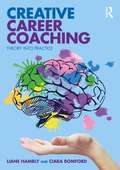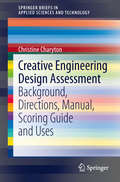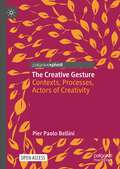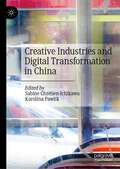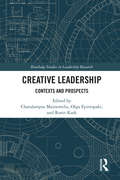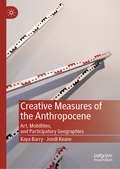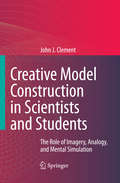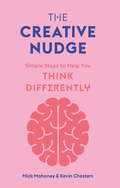- Table View
- List View
The Creative Capital of Cities: Interactive Knowledge Creation and the Urbanization Economies of Innovation (IJURR Studies in Urban and Social Change Book Series #79)
by Stefan KrätkeThis book challenges the new urban growth concepts of the creative class and creative industries from a critical urban theory perspective. Critiques Richard Florida's popular books about cities and the creative class Presents an alternative approach based on analyses of empirical research data concerning the German urban system and the case study regions, Hanover and Berlin Underscores that the culture industry takes a leading role in conforming with neoliberal conceptions of labor markets
The Creative Capital of Cities: Interactive Knowledge Creation and the Urbanization Economies of Innovation (IJURR Studies in Urban and Social Change Book Series #77)
by Stefan KrätkeThis book challenges the new urban growth concepts of the creative class and creative industries from a critical urban theory perspective. Critiques Richard Florida's popular books about cities and the creative class Presents an alternative approach based on analyses of empirical research data concerning the German urban system and the case study regions, Hanover and Berlin Underscores that the culture industry takes a leading role in conforming with neoliberal conceptions of labor markets
Creative Career Coaching: Theory into Practice
by Liane Hambly Ciara BomfordCreative Career Coaching: Theory into Practice is an innovative book for career development students and professionals aiming to creatively progress their coaching practice. Without losing sight of fundamental coaching values and practices, it encourages career development professionals to adapt their practice by harnessing imagination, intuition and critical reflection to engage clients. Hambly and Bomford consider the usefulness of creativity alongside traditional coaching models to reach "harder to help" groups. They consider a whole-brain approach to creativity, emphasising the need for coaches to adapt their client-facing skills for individual cases. They work through how clients make career decisions, how to use labour market information to motivate clients, how to frame a creative coaching session using techniques such as metaphor, visualisation and role play, how to use practical tools and techniques to resolve a client’s individual needs, and how to deliver on digital platforms. Combining the latest neuroscientific research with activities, summaries and case studies, this book provides a practical, skills-based approach to coaching. Creative Career Coaching: Theory into Practice is the first book to summarise the Creative Career Coaching Model. It will be an indispensable resource for students of career development, career coaching, coaching psychology and advice and guidance courses. It will also be of interest to career coaches in practice seeking to enhance their skills.
Creative Career Coaching: Theory into Practice
by Liane Hambly Ciara BomfordCreative Career Coaching: Theory into Practice is an innovative book for career development students and professionals aiming to creatively progress their coaching practice. Without losing sight of fundamental coaching values and practices, it encourages career development professionals to adapt their practice by harnessing imagination, intuition and critical reflection to engage clients. Hambly and Bomford consider the usefulness of creativity alongside traditional coaching models to reach "harder to help" groups. They consider a whole-brain approach to creativity, emphasising the need for coaches to adapt their client-facing skills for individual cases. They work through how clients make career decisions, how to use labour market information to motivate clients, how to frame a creative coaching session using techniques such as metaphor, visualisation and role play, how to use practical tools and techniques to resolve a client’s individual needs, and how to deliver on digital platforms. Combining the latest neuroscientific research with activities, summaries and case studies, this book provides a practical, skills-based approach to coaching. Creative Career Coaching: Theory into Practice is the first book to summarise the Creative Career Coaching Model. It will be an indispensable resource for students of career development, career coaching, coaching psychology and advice and guidance courses. It will also be of interest to career coaches in practice seeking to enhance their skills.
The Creative Class Goes Global (Regions and Cities)
by Charlotta Mellander Richard Florida Bjørn T. Asheim Meric GertlerCharlotta Mellander Meric GertlerThe whole landscape of research in urban studies was revolutionized by the publication of Richard Florida’s The Rise of the Creative Class in 2002, and his subsequent book entitled The Flight of the Creative Class has helped to maintain a decade-long explosion of interest in the field. While these two books examine the creative class in the context of the United States, research has emerged which investigates the creative class worldwide. This book brings together detailed studies of the creative class in cities across the globe, examining the impact of the creative class on growth and development. The countries covered include the United Kingdom, the Netherlands, Germany, Australia, China, Japan and Canada, in addition to the United States. Taken together, the contributions deepen our understanding of the creative class and the various factors that affect regional development, highlighting the similarities and differences between the creative class and economic development across countries. This book will be of great interest to scholars of economic geography, regional economics, urban sociology and cultural policy, as well as policy makers involved in urban development.
The Creative Class Goes Global (Regions and Cities)
by Charlotta Mellander Richard Florida Meric Gertler Bjørn T. AsheimThe whole landscape of research in urban studies was revolutionized by the publication of Richard Florida’s The Rise of the Creative Class in 2002, and his subsequent book entitled The Flight of the Creative Class has helped to maintain a decade-long explosion of interest in the field. While these two books examine the creative class in the context of the United States, research has emerged which investigates the creative class worldwide. This book brings together detailed studies of the creative class in cities across the globe, examining the impact of the creative class on growth and development. The countries covered include the United Kingdom, the Netherlands, Germany, Australia, China, Japan and Canada, in addition to the United States. Taken together, the contributions deepen our understanding of the creative class and the various factors that affect regional development, highlighting the similarities and differences between the creative class and economic development across countries. This book will be of great interest to scholars of economic geography, regional economics, urban sociology and cultural policy, as well as policy makers involved in urban development.
The Creative Destruction of New York City: Engineering the City for the Elite
by Alessandro BusàBill de Blasio's campaign rhetoric focused on a tale of two cities: rich and poor New York. He promised to value the needs of poor and working-class New Yorkers, making city government work better for everyone-not just those who thrived during Bloomberg's tenure as mayor. But well into de Blasio's administration, many critics think that little has changed in the lives of struggling New Yorkers, and that the gentrification of New York City is expanding at a record pace across the five boroughs. Despite the mayor's goal of creating more affordable housing, Brooklyn and Manhattan sit atop the list of the most unaffordable housing markets in the country. It seems that the old adage is becoming truer: New York is a place for only the very rich and the very poor. In The Creative Destruction of New York City, urban scholar Alessandro Busà travels to neighborhoods across the city, from Harlem to Coney Island, from Hell's Kitchen to East New York, to tell the story of fifteen years of drastic rezoning and rebranding, updating the tale of two New Yorks. There is a gilded city of sky-high glass towers where Wall Street managers and foreign billionaires live-or merely store their cash. And there is another New York: a place where even the professional middle class is one rent hike away from displacement. Despite de Blasio's rhetoric, the trajectory since Bloomberg has been remarkably consistent. New York's urban development is changing to meet the consumption demands of the very rich, and real estate moguls' power has never been greater. Major players in real estate, banking, and finance have worked to ensure that, regardless of changes in leadership, their interests are safeguarded at City Hall. The Creative Destruction of New York City is an important chronicle of both the success of the city's elite and of efforts to counter the city's march toward a glossy and exclusionary urban landscape. It is essential reading for everyone who cares about affordable housing access and, indeed, the soul of New York City.
The Creative Destruction of New York City: Engineering the City for the Elite
by Alessandro BusàBill de Blasio's campaign rhetoric focused on a tale of two cities: rich and poor New York. He promised to value the needs of poor and working-class New Yorkers, making city government work better for everyone-not just those who thrived during Bloomberg's tenure as mayor. But well into de Blasio's administration, many critics think that little has changed in the lives of struggling New Yorkers, and that the gentrification of New York City is expanding at a record pace across the five boroughs. Despite the mayor's goal of creating more affordable housing, Brooklyn and Manhattan sit atop the list of the most unaffordable housing markets in the country. It seems that the old adage is becoming truer: New York is a place for only the very rich and the very poor. In The Creative Destruction of New York City, urban scholar Alessandro Busà travels to neighborhoods across the city, from Harlem to Coney Island, from Hell's Kitchen to East New York, to tell the story of fifteen years of drastic rezoning and rebranding, updating the tale of two New Yorks. There is a gilded city of sky-high glass towers where Wall Street managers and foreign billionaires live-or merely store their cash. And there is another New York: a place where even the professional middle class is one rent hike away from displacement. Despite de Blasio's rhetoric, the trajectory since Bloomberg has been remarkably consistent. New York's urban development is changing to meet the consumption demands of the very rich, and real estate moguls' power has never been greater. Major players in real estate, banking, and finance have worked to ensure that, regardless of changes in leadership, their interests are safeguarded at City Hall. The Creative Destruction of New York City is an important chronicle of both the success of the city's elite and of efforts to counter the city's march toward a glossy and exclusionary urban landscape. It is essential reading for everyone who cares about affordable housing access and, indeed, the soul of New York City.
Creative Engineering Design Assessment: Background, Directions, Manual, Scoring Guide and Uses (SpringerBriefs in Applied Sciences and Technology)
by Christine CharytonThe Creative Engineering Design Assessment or CEDA is a newly developed tool to assess creativity specific to engineering design which is vital for innovation. The revised CEDA assesses usefulness in addition to originality. Both originality and usefulness are key constructs in creativity but are primarily essential and emphasized ever more in engineering design. Since the preliminary research was presented to the National Science Foundation, further reliability and validity has been developed and established. The CEDA is different from other general creativity measures as it demonstrates discriminant validity with the Creative Personality Scale, Creative Temperament Scale, and the Cognitive Risk Tolerance Scale, and has demonstrated convergent validity with the Purdue Creativity Test and the Purdue Spatial Visualization Test- Rotations. It focuses on engineering specific measures, measuring engineering creativity and spatial skills.The aim of this book is to disseminate the CEDA tool for use in engineering educational programs, industry, NASA and the military. Creative Engineering Design Assessment (CEDA) Background, Directions, Manual, Scoring Guide and Uses discusses and outlines the need for creativity in our global economy and in engineering design and provides the CEDA tool in effort to achieve this.
Creative Explorations: New Approaches to Identities and Audiences
by David GauntlettHow do you picture identity? What happens when you ask individuals to make visual representations of their own identities, influences, and relationships? Drawing upon an array of disciplines from neuroscience to philosophy, and art to social theory, David Gauntlett explores the ways in which researchers can embrace people's everyday creativity in order to understand social experience. Seeking an alternative to traditional interviews and focus groups, he outlines studies in which people have been asked to make visual things – such as video, collage, and drawing – and then interpret them. This leads to an innovative project in which Gauntlett asked people to build metaphorical models of their identities in Lego. This creative reflective method provides insights into how individuals present themselves, understand their own life story, and connect with the social world. Creative Explorations is a lively and original discussion of identities, media influences, and creativity, which will be of interest to both students and academics.
Creative Explorations: New Approaches to Identities and Audiences
by David GauntlettHow do you picture identity? What happens when you ask individuals to make visual representations of their own identities, influences, and relationships? Drawing upon an array of disciplines from neuroscience to philosophy, and art to social theory, David Gauntlett explores the ways in which researchers can embrace people's everyday creativity in order to understand social experience. Seeking an alternative to traditional interviews and focus groups, he outlines studies in which people have been asked to make visual things – such as video, collage, and drawing – and then interpret them. This leads to an innovative project in which Gauntlett asked people to build metaphorical models of their identities in Lego. This creative reflective method provides insights into how individuals present themselves, understand their own life story, and connect with the social world. Creative Explorations is a lively and original discussion of identities, media influences, and creativity, which will be of interest to both students and academics.
Creative Families: Gender and Technologies of Everyday Life (Palgrave Studies in Mediating Kinship, Representation, and Difference)
by Jana Mikats Susanne Kink-Hampersberger Libora Oates-IndruchováThis edited collection brings together two strands of current discussions in gender research through the concept of creativity. First, it addresses creativity in the context of the family, by exploring changing and newly emergent family forms and ways of creating and maintaining intimate relationships. Creativity here is understood not as just “newness or originality,” but as that which, in the words of Eisler and Montouri (2007), “supports, nurtures, and actualizes life by increasing the number of choices open to individuals and communities.” One aim of this book, therefore, is to investigate the social, collaborative, and creative interactions in contemporary family and kin formations in Europe. Second, the volume examines how new media and technologies are entering and shaping everyday family lives. Technological transformations and adaptions have not only enabled the creation of new forms of families and ways of family living, but also challenged the established constellations of gender and family arrangements. The present volume addresses these issues from multiple perspectives and in different contexts, and explores the involvement of different actors. By problematizing the creativity of becoming and “doing” family and kinship, the authors acknowledge the increasing fluidity of gender identities, the evolving diversity of relationships, and the permeation of technology into daily life.
The Creative Gesture: Contexts, Processes, Actors of Creativity (Palgrave Studies in Creativity and Culture)
by Pier Paolo BelliniThis open access book offers a concise overview of the theories constructed within the various human sciences around the theme of creativity as a symbolic capacity to link things together: it manifests itself when the individual endowed with a certain type of intelligence encounters cultural and social conditions that enable them to develop that capacity to the maximum, rather than inhibiting it or diverting it to other fields where it is doomed to failure. Even the most intimate of human expressiveness is considered as a result of an active social relationality. Social dimensions of creativity (evaluation, primary socialization, motivation, leadership) and “creative processes” (creative attitude, creative gesture, divergent thinking, problem-solving capacity, interdisciplinary approach, randomness, algorithmic creativity) are also analysed.The book concludes by evaluating the course taken in the light of the relational theory of society: the development of creativity cannot beconceived outside of self-other relations.This book is the result of a translation done with the help of artificial intelligence. The text has subsequently been revised further by a professional copy editor in order to refine the work stylistically.
Creative Hubs in Question: Place, Space and Work in the Creative Economy (Dynamics of Virtual Work)
by Rosalind Gill Andy C. Pratt Tarek E. ViraniCreative hubs have become a cornerstone of economic and cultural policy with only the barest amount of discussion or scrutiny. This volume offers the first interrogation of creative hubs, with ground-breaking critical writing from a combination of established scholars and new voices. Looking across multiple sites trans-nationally, and combining theoretical and empirical reflections, it asks: what are creative hubs, why do they matter, and are they making the world a better place?Creative Hubs in Question discusses creative hubs in relation to debates about creative cities, co-working spaces and workers' co-operatives. Featuring case studies from Argentina to the Netherlands, and Nigeria to the UK, the contributions address how hubs are situated in relation to projects of equality and social justice, and whether and in what ways they change the experiences of the creatives who work in them. Drawing on a range of disciplinary perspectives including sociology, geography, economics, media and communications, culture and creative industries, critical policy studies, gender studies, race and ethnicity, and urban studies, this collection will be of interest to policy makers, academics, scholars, students and practitioners across these fields.
Creative Industries and Digital Transformation in China
by Sabine Chrétien-Ichikawa Karolina PawlikAs China gains momentum in economic terms, its technological transformation, cultural confidence, and creative influence also grow steadily. This book explores socio-cultural context, in which new trends, enabled by the power of digital technology, emerge. Focused on the urban context, in China's large cities like Shanghai, and through the lens of art, design, fashion, gaming, and media industries, this book highlights innovation processes in the making, as well as ongoing shifts in Chinese identities and narratives. This collaborative work written by European authors based in China offer new insights from within. Their shared, yet multi-faceted, engagement with China and its creative industries culminates in this book written for international scholars, students, and industry players.
Creative Leadership: Contexts and Prospects (Routledge Studies in Leadership Research)
by Charalampos Mainemelis Olga Epitropaki Ronit KarkThere has never been a better time to study, practice, and experience creative leadership. In the fluid and turbulent economic and social environments of the 21st century, creative leadership has become a cardinal force in the creation and evolution of adaptive organizations. In the last two decades, organizational science has witnessed a rapid increase in the number of studies on the nature, skills, and processes of creative leadership. The resulting accumulated body of knowledge has remained for many years dispersed and fragmented across multiple strands of organizational research. This volume seeks to foster the cross-fertilization of scientific knowledge and insight by bringing together authoritative contributions from leading scholars whose work is located in different strands of creative leadership research. Creative Leadership: Contexts and Prospects builds upon a recently introduced multi-context framework that integrates metatheoretically three conceptualizations of creative leadership found in the extant literature: Facilitating employee creativity; Directing the materialization of a leader’s creative vision; and Integrating heterogeneous creative contributions. These three conceptualizations reflect essential differences in the enactment of creative leadership across various collaborative contexts of creative work, and they underlie the intellectual efforts of different research strands. The collection of chapters in Creative Leadership: Contexts and Prospects offers the latest thinking on creative leadership in facilitative, directive, and integrative contexts, and a stimulating set of ideas for crafting the next generation of nuanced theories and empirical studies in the field.
Creative Leadership: Contexts and Prospects (Routledge Studies in Leadership Research)
by Charalampos Mainemelis Olga Epitropaki Ronit KarkThere has never been a better time to study, practice, and experience creative leadership. In the fluid and turbulent economic and social environments of the 21st century, creative leadership has become a cardinal force in the creation and evolution of adaptive organizations. In the last two decades, organizational science has witnessed a rapid increase in the number of studies on the nature, skills, and processes of creative leadership. The resulting accumulated body of knowledge has remained for many years dispersed and fragmented across multiple strands of organizational research. This volume seeks to foster the cross-fertilization of scientific knowledge and insight by bringing together authoritative contributions from leading scholars whose work is located in different strands of creative leadership research. Creative Leadership: Contexts and Prospects builds upon a recently introduced multi-context framework that integrates metatheoretically three conceptualizations of creative leadership found in the extant literature: Facilitating employee creativity; Directing the materialization of a leader’s creative vision; and Integrating heterogeneous creative contributions. These three conceptualizations reflect essential differences in the enactment of creative leadership across various collaborative contexts of creative work, and they underlie the intellectual efforts of different research strands. The collection of chapters in Creative Leadership: Contexts and Prospects offers the latest thinking on creative leadership in facilitative, directive, and integrative contexts, and a stimulating set of ideas for crafting the next generation of nuanced theories and empirical studies in the field.
Creative Marginality: Innovation At The Intersections Of Social Sciences
by Mattei DoganTracing the nine formal social science disciplines - political science, sociology, economics, history, anthropology, philosophy, geography, psychology, and linguistics - through their cycles of growth, specialization, fragmentation and hybridization, Dogan and Pahre reject the notion of catch-all "interdisciplinary" research. They set out to demon
Creative Marginality: Innovation At The Intersections Of Social Sciences
by Mattei DoganTracing the nine formal social science disciplines - political science, sociology, economics, history, anthropology, philosophy, geography, psychology, and linguistics - through their cycles of growth, specialization, fragmentation and hybridization, Dogan and Pahre reject the notion of catch-all "interdisciplinary" research. They set out to demon
Creative Measures of the Anthropocene: Art, Mobilities, and Participatory Geographies
by Kaya Barry Jondi KeaneThis book proposes that creative and participatory modes of measuring, knowing, and moving in the world are needed for coming to grips with the Anthropocene epoch. It interrogates how creative, affective and experiential encounters that traverse the local and the global, as well as the mundane and the everyday, can offer new perspectives on the challenges that lay ahead. This book considers the role of the arts in exploring geographical concerns and increasing human mobility. In doing so, it offers ways to counteract the unstable, shifting and disorienting impacts and debates surrounding human activity and the Anthropocene. The authors bring together perspectives from mobilities, creative arts, cultural geography, philosophy and humanities in an innovative exploration of how creative forms of measurement can assist in reconfiguring individual and collective action.
Creative Model Construction in Scientists and Students: The Role of Imagery, Analogy, and Mental Simulation
by John ClementHow do scientists use analogies and other processes to break away from old theories and generate new ones? This book documents such methods through the analysis of video tapes of scientifically trained experts thinking aloud while working on unfamiliar problems. Some aspects of creative scientific thinking are difficult to explain, such as the power of analogies, and the enigmatic ability to learn from thought experiments. This book is a window on that world.
The Creative Nudge: Simple Steps to Help You Think Differently
by Kevin Chesters Mick MahoneyCreative thinking is something everyone can do. It's a way of looking at the world afresh, doing new things in new ways, taking risks. With The Creative Nudge, use 'nudge theory' to unleash your innate originality. A new behavioural science that reveals how small actions can have big impacts on our thinking, nudge theory powers this book. Using simple behaviour changes, retrain your brain and live a more creative and rewarding life.
Creative People at Work: Twelve Cognitive Case Studies
by Doris B. Wallace Howard E. GruberTo demystify creative work without reducing it to simplistic formulas, Doris Wallace and Howard Gruber, one of the world's foremost authorities on creativity, have produced a unique book exploring the creative process in the arts and sciences. The book's original "evolving systems approach" treats creativity as purposeful work and integrates cognitive, emotional, aesthetic, and motivational aspects of the creative process. Twelve revealing case studies explore the work of such diverse people as William Wordsworth, Albert Einstein, Jean Piaget, Anais Nin, and Charles Darwin. The case study approach is discussed in relation to other methods such as biography, autobiography, and psychobiology. Emphasis is given to the uniqueness of each creative person; the social nature of creative work is also treated without losing the sense of the individual. A final chapter considers the relationship between creativity and morality in the nuclear age. In addition to developmental psychologists and cognitive scientists, this study offers fascinating insights for all readers interested in the history of ideas, scientific discovery, artistic innovation, and the interplay of intuition, inspiration, and purposeful work.
Creative Play and Drama with Adults at Risk
by Sue JenningsThis hands-on manual offers a clear introduction to play and drama work for professionals working with adults at risk. Many adults feel nervous about drama and think that play is childish. Sue Jennings shows that by participating in play and drama people can make a difference to how they feel about themselves and the world around them. This book is suitable for professionals working with adults who are vulnerable for a number of different reasons: those who have addictions such as eating disorders, drug and alcohol abuse or a history of violent relationships; adults with mental ill health; individuals and families with behavioural difficulties; people in forensic settings; those with multiple disabilities; learning impaired adults; people with strokes and other physical impairment often as a result of accidental injury. Material is chosen sensitively to enable confidence and creativity building, and the development of communication skills. Photocopiable worksheets offer the professional activities that will encourage trust and collaboration; foster independence and choice, maximise people's learning potential and stimulate everyone's imagination and creativity. Ideas are given for improvisation and movement as well as masks and myths. Cross-cultural perspectives are discussed together with boundaries for clinical groups. The importance of the healing potential of artistic expression is addressed throughout.
Creative Play and Drama with Adults at Risk
by Sue JenningsThis hands-on manual offers a clear introduction to play and drama work for professionals working with adults at risk. Many adults feel nervous about drama and think that play is childish. Sue Jennings shows that by participating in play and drama people can make a difference to how they feel about themselves and the world around them. This book is suitable for professionals working with adults who are vulnerable for a number of different reasons: those who have addictions such as eating disorders, drug and alcohol abuse or a history of violent relationships; adults with mental ill health; individuals and families with behavioural difficulties; people in forensic settings; those with multiple disabilities; learning impaired adults; people with strokes and other physical impairment often as a result of accidental injury. Material is chosen sensitively to enable confidence and creativity building, and the development of communication skills. Photocopiable worksheets offer the professional activities that will encourage trust and collaboration; foster independence and choice, maximise people's learning potential and stimulate everyone's imagination and creativity. Ideas are given for improvisation and movement as well as masks and myths. Cross-cultural perspectives are discussed together with boundaries for clinical groups. The importance of the healing potential of artistic expression is addressed throughout.


